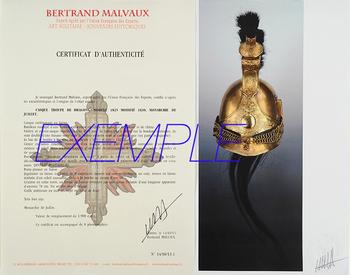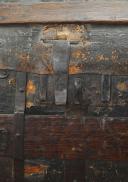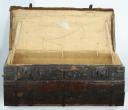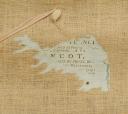
TRANSPORT TRUNK FOR THE WARDROBE OF SAS MONSEIGNEUR LOUIS V JOSEPH DE BOURBON-CONDÉ, PRINCE DE CONDÉ, 2nd HALF 18th century
TRANSPORT TRUNK FOR THE WARDROBE OF SAS MONSEIGNEUR LOUIS V JOSEPH DE BOURBON-CONDÉ, PRINCE DE CONDÉ, 2nd HALF 18th century
Humpback trunk in the shape of a sideboard, in studded leather with a wood and iron frame, rectangular in shape with a domed lid closing with a lock with two handles on each side; interior lined with canvas; remains of a label from the supplier of the time in black printed white paper on which one can still read “FRANCE & des Petits-A S. Germain À PARIS NCOT NIER DU PRINCE DE ale Militaire; ". The lid is inscribed with brass nails: "GARDEROBE DE.S.A.S.Mgr.LE PRINCE. DE CONDÉ", and on a small sheet metal plate the engraved inscription "N° I". Reinforced on the outside with wide bands of chestnuts. H 56 cm, W 115 cm, D 0.54 cm. Good condition, some lacks and wear mainly to the leather.
PROVENANCE: This trunk was given to Jean Brunon by his mother-in-law from Saint-Roman. It comes from the Stops of the Hôtel de Catel, 6 place Saint-Étienne in Toulouse, property of the Saint-Romans. Another trunk bore an inscription of belonging to a Saint-Roman (it has now disappeared). The trunk of the Prince of Condé contains an old plaque whose location is visible on the lid, it bears the inscription: Mgr le duc d'Enghein.
HISTORY: The wardrobe trunks made it possible to transport the finery of the royal family and large families during Court trips to royal residences according to the seasons. Each prince of the royal family had his own contingent, captioned and numbered with nails. These royal luggage in the form of trunks and chests are provided by the Crown layetiers. Trades formed by workers who made chests, wooden boxes generally used as packaging. In addition to the travel trunks, there were other chests, boxes and trunks in use in the wardrobes of the finery. We also know that the "loans" of the wardrobes were transported through the castle from the finery to the royal bedrooms, in padlocked chests or baskets covered with sewn taffeta to prevent poisoning or theft. A dedicated charge, that of trunk door existed in the King's House. Trolleys followed or preceded by a few days the arrival of illustrious travelers during trips to Compiègne (in summer), Fontainebleau (in autumn), Marly or Choisy. Widely used and often replaced, these trunks have practically all disappeared, due to the numerous movements of the court, witnesses of the nomadism of the court of France, inherited from the Valois.
KNOWN COPIES: Three copies are kept at the Palaces of Versailles and Trianon:
- Queen Marie-Antoinette's bedroom travel trunk No. 8 (marked with brush No. 2), acquisition 2005. H 5 cm, W 112 cm, D 5 cm.
- Queen Marie-Antoinette's bedroom trunk No. 9, marked "A Muller". H 50 cm, W 110 cm, D 51 cm. Sold at Sotheby's in Paris, March 23, 2006 (lot 89); offered by Mr. and Mrs. Bernard Steinitz, the same year.
- Madame La Dauphine's wardrobe travel trunk No. 10 (deposit of the City of Paris since 2005). H 5 cm, W 112 cm, D 52 cm
- The Compiègne car and tourism museum also has a collection of travel trunks from all periods, such as the travel trunk of the Countess of Forcalquier, Lady of Honor of the Countess of Artois.
- Small chest from La Chapelle du Roi, probably intended to transport sheet music or musical instruments, also kept at the Palaces of Versailles and Trianon. H 93 cm, W 116 cm, D 6 cm.
- Trunk from the room of the Dauphine Marie-Antoinette, future Queen of France and wife of King Louis XVI. With inscription on the lid in small brass studs "CHAMBRE DE ME LA DAUPHINE N° 4". Marked in ink on the front "A MA" (or "MO"). Around 1770-1774. AUDAP ET ASSOCIES sale of June 8, 2021
- Trunk of the "GARBE DE LA DAUPHINE N° 5". Osenat, Versailles, sale of November 15, 2020.
BIOGRAPHY: Louis V Joseph de Bourbon-Condé, 8th Prince of Condé (1740), prince of the blood, was born in Paris on August 9, 1736 and died in Chantilly on May 13, 1818. Son of Louis IV Henri de Bourbon-Condé (1692 -1740), Duke of Bourbon then 7th Prince of Condé, and Princess née Caroline von Hessen-Rheinfels-Rotenburg (1714-1741). As a child, Louis-Joseph bore the title of Duke of Enghien. On the death of his father in 1740, he became Grand Master of France. He was still only 5 years old when his mother also died a year later. He was then entrusted to the care of his paternal uncle, Louis, Count of Clermont. Four years older than the Marquis de Sade, also born at the Hôtel de Condé (his mother being a relative and lady-in-waiting to the Princess), brought up with him until the age of eight, he was the godfather of his son Louis-Marie, baptized in the private chapel of the Condés in Chantilly. On May 3, 1753 he married in Versailles, Charlotte de Rohan (1737-1760), daughter of Charles de Rohan, Prince of Soubise, Duke of Rohan-Rohan (1715-1787) and Anne Marie-louise de La Tour d' Auvergne (1722-1739). Louis-Joseph is still only 13 years old and his young wife is three years his senior. During the Seven Years' War he served with some distinction alongside his father-in-law the Prince of Soubise. He was appointed lieutenant general of the king's armies in 1758 and won the rare French victories at Grüningen and Johannisberg (1762). He then administered Burgundy. In 1764, he renovated and enlarged the Palais Bourbon and left the Hôtel de Condé where he was born. He also embellished the Château de Chantilly. In 1765, he inherited from his paternal aunt Élisabeth Alexandrine de Bourbon, and received the generous thought that Elisabeth Alexandrine had herself bought it from her cousin Mademoiselle du Maine. In 1770, he married his son to Bathilde d'Orléans, daughter of Louis-Philippe, Duke of Orléans and sister of Philippe Égalité. The marriage is supposed to heal relations between the Condés and the Orléans, all descendants of the illegitimate daughters of Louis XIV and Madame de Montespan. By the ordinance of April 5, 1780, King Louis XVI recreated the rank of Colonel General of the Infantry for him. During the French Revolution, although passing for liberal, he opposed the doubling of the third estate. He is one of the first to leave France, and emigrates just after the storming of the Bastille in the Netherlands and then in Turin. He organized an army in Worms, on the banks of the Rhine, while the king's brothers established their headquarters in Koblenz. Anxious to closely control the movements of emigrants, the Austrians and Prussians kept him out of military operations in 1792 and subordinated him to an Austrian general in 1793. Stationed on the banks of the Rhine in 1794 and 1795, the army of Condé then passes under the control of Great Britain, Austria which successively ensure its maintenance. In 1797, after the Treaty of Campo-Formio, Condé's army entered the service of the Tsar of Russia. After the treaty of Lunéville, having performed prodigies of value at Wissembourg, Haguenau and Bentheim to no avail, the prince was obliged to dismiss his army and retired in 1800 to Great Britain with his son. They stay in Wanstead, served by servants whose wages are paid only irregularly but continuing to observe the ceremonial of the Old Regime. They receive from George III a pension of 675 pounds for two. From London, he sends bellicose instructions to his grandson, the Duc d'Enghien, without realizing that times have changed. He was kidnapped, sentenced to death and executed in 1804 on the orders of Consul Bonaparte. In 1814, he returned to France with Louis XVIII and, despite his great age (78), regained his position as Grand Master of the King's Household, which earned him a regular attendance at the court of the Tuileries, which his son deserted. He died in Chantilly in 1818, at the age of 81.
Photo credit (C) RMN-Grand Palais (Château de Versailles) / Gérard Blot.
Humpback trunk in the shape of a sideboard, in studded leather with a wood and iron frame, rectangular in shape with a domed lid closing with a lock with two handles on each side; interior lined with canvas; remains of a label from the supplier of the time in black printed white paper on which one can still read “FRANCE & des Petits-A S. Germain À PARIS NCOT NIER DU PRINCE DE ale Militaire; ". The lid is inscribed with brass nails: "GARDEROBE DE.S.A.S.Mgr.LE PRINCE. DE CONDÉ", and on a small sheet metal plate the engraved inscription "N° I". Reinforced on the outside with wide bands of chestnuts. H 56 cm, W 115 cm, D 0.54 cm. Good condition, some lacks and wear mainly to the leather.
PROVENANCE: This trunk was given to Jean Brunon by his mother-in-law from Saint-Roman. It comes from the Stops of the Hôtel de Catel, 6 place Saint-Étienne in Toulouse, property of the Saint-Romans. Another trunk bore an inscription of belonging to a Saint-Roman (it has now disappeared). The trunk of the Prince of Condé contains an old plaque whose location is visible on the lid, it bears the inscription: Mgr le duc d'Enghein.
HISTORY: The wardrobe trunks made it possible to transport the finery of the royal family and large families during Court trips to royal residences according to the seasons. Each prince of the royal family had his own contingent, captioned and numbered with nails. These royal luggage in the form of trunks and chests are provided by the Crown layetiers. Trades formed by workers who made chests, wooden boxes generally used as packaging. In addition to the travel trunks, there were other chests, boxes and trunks in use in the wardrobes of the finery. We also know that the "loans" of the wardrobes were transported through the castle from the finery to the royal bedrooms, in padlocked chests or baskets covered with sewn taffeta to prevent poisoning or theft. A dedicated charge, that of trunk door existed in the King's House. Trolleys followed or preceded by a few days the arrival of illustrious travelers during trips to Compiègne (in summer), Fontainebleau (in autumn), Marly or Choisy. Widely used and often replaced, these trunks have practically all disappeared, due to the numerous movements of the court, witnesses of the nomadism of the court of France, inherited from the Valois.
KNOWN COPIES: Three copies are kept at the Palaces of Versailles and Trianon:
- Queen Marie-Antoinette's bedroom travel trunk No. 8 (marked with brush No. 2), acquisition 2005. H 5 cm, W 112 cm, D 5 cm.
- Queen Marie-Antoinette's bedroom trunk No. 9, marked "A Muller". H 50 cm, W 110 cm, D 51 cm. Sold at Sotheby's in Paris, March 23, 2006 (lot 89); offered by Mr. and Mrs. Bernard Steinitz, the same year.
- Madame La Dauphine's wardrobe travel trunk No. 10 (deposit of the City of Paris since 2005). H 5 cm, W 112 cm, D 52 cm
- The Compiègne car and tourism museum also has a collection of travel trunks from all periods, such as the travel trunk of the Countess of Forcalquier, Lady of Honor of the Countess of Artois.
- Small chest from La Chapelle du Roi, probably intended to transport sheet music or musical instruments, also kept at the Palaces of Versailles and Trianon. H 93 cm, W 116 cm, D 6 cm.
- Trunk from the room of the Dauphine Marie-Antoinette, future Queen of France and wife of King Louis XVI. With inscription on the lid in small brass studs "CHAMBRE DE ME LA DAUPHINE N° 4". Marked in ink on the front "A MA" (or "MO"). Around 1770-1774. AUDAP ET ASSOCIES sale of June 8, 2021
- Trunk of the "GARBE DE LA DAUPHINE N° 5". Osenat, Versailles, sale of November 15, 2020.
BIOGRAPHY: Louis V Joseph de Bourbon-Condé, 8th Prince of Condé (1740), prince of the blood, was born in Paris on August 9, 1736 and died in Chantilly on May 13, 1818. Son of Louis IV Henri de Bourbon-Condé (1692 -1740), Duke of Bourbon then 7th Prince of Condé, and Princess née Caroline von Hessen-Rheinfels-Rotenburg (1714-1741). As a child, Louis-Joseph bore the title of Duke of Enghien. On the death of his father in 1740, he became Grand Master of France. He was still only 5 years old when his mother also died a year later. He was then entrusted to the care of his paternal uncle, Louis, Count of Clermont. Four years older than the Marquis de Sade, also born at the Hôtel de Condé (his mother being a relative and lady-in-waiting to the Princess), brought up with him until the age of eight, he was the godfather of his son Louis-Marie, baptized in the private chapel of the Condés in Chantilly. On May 3, 1753 he married in Versailles, Charlotte de Rohan (1737-1760), daughter of Charles de Rohan, Prince of Soubise, Duke of Rohan-Rohan (1715-1787) and Anne Marie-louise de La Tour d' Auvergne (1722-1739). Louis-Joseph is still only 13 years old and his young wife is three years his senior. During the Seven Years' War he served with some distinction alongside his father-in-law the Prince of Soubise. He was appointed lieutenant general of the king's armies in 1758 and won the rare French victories at Grüningen and Johannisberg (1762). He then administered Burgundy. In 1764, he renovated and enlarged the Palais Bourbon and left the Hôtel de Condé where he was born. He also embellished the Château de Chantilly. In 1765, he inherited from his paternal aunt Élisabeth Alexandrine de Bourbon, and received the generous thought that Elisabeth Alexandrine had herself bought it from her cousin Mademoiselle du Maine. In 1770, he married his son to Bathilde d'Orléans, daughter of Louis-Philippe, Duke of Orléans and sister of Philippe Égalité. The marriage is supposed to heal relations between the Condés and the Orléans, all descendants of the illegitimate daughters of Louis XIV and Madame de Montespan. By the ordinance of April 5, 1780, King Louis XVI recreated the rank of Colonel General of the Infantry for him. During the French Revolution, although passing for liberal, he opposed the doubling of the third estate. He is one of the first to leave France, and emigrates just after the storming of the Bastille in the Netherlands and then in Turin. He organized an army in Worms, on the banks of the Rhine, while the king's brothers established their headquarters in Koblenz. Anxious to closely control the movements of emigrants, the Austrians and Prussians kept him out of military operations in 1792 and subordinated him to an Austrian general in 1793. Stationed on the banks of the Rhine in 1794 and 1795, the army of Condé then passes under the control of Great Britain, Austria which successively ensure its maintenance. In 1797, after the Treaty of Campo-Formio, Condé's army entered the service of the Tsar of Russia. After the treaty of Lunéville, having performed prodigies of value at Wissembourg, Haguenau and Bentheim to no avail, the prince was obliged to dismiss his army and retired in 1800 to Great Britain with his son. They stay in Wanstead, served by servants whose wages are paid only irregularly but continuing to observe the ceremonial of the Old Regime. They receive from George III a pension of 675 pounds for two. From London, he sends bellicose instructions to his grandson, the Duc d'Enghien, without realizing that times have changed. He was kidnapped, sentenced to death and executed in 1804 on the orders of Consul Bonaparte. In 1814, he returned to France with Louis XVIII and, despite his great age (78), regained his position as Grand Master of the King's Household, which earned him a regular attendance at the court of the Tuileries, which his son deserted. He died in Chantilly in 1818, at the age of 81.
Photo credit (C) RMN-Grand Palais (Château de Versailles) / Gérard Blot.
Price :
6 500,00 €
Shipping France :
600,00 €
Shipping Europe : 800,00 €
Shipping world : 1 300,00 €
Shipping Europe : 800,00 €
Shipping world : 1 300,00 €
Insurance (1%) :
65,00 €
Reference :
12394

Next update Friday, december 19 at 13:30 PM
FOR ALL PURCHASES, PAYMENT IN MULTIPLE CHECKS POSSIBLE
bertrand.malvaux@wanadoo.fr 06 07 75 74 63
SHIPPING COSTS
Shipping costs are calculated only once per order for one or more items, all shipments are sent via registered mail, as this is the only way to have proof of dispatch and receipt.
For parcels whose value cannot be insured by the Post, shipments are entrusted to DHL or Fedex with real value insured, the service is of high quality but the cost is higher.
RETURN POLICY
Items can be returned within 8 days of receipt. They must be returned by registered mail at the sender's expense, in their original packaging, and in their original condition.
AUTHENTICITY
The selection of items offered on this site allows me to guarantee the authenticity of each piece described here, all items offered are guaranteed to be period and authentic, unless otherwise noted or restricted in the description.
An authenticity certificate of the item including the description published on the site, the period, the sale price, accompanied by one or more color photographs is automatically provided for any item priced over 130 euros. Below this price, each certificate is charged 5 euros.
Only items sold by me are subject to an authenticity certificate, I do not provide any expert reports for items sold by third parties (colleagues or collectors).
FOR ALL PURCHASES, PAYMENT IN MULTIPLE CHECKS POSSIBLE
bertrand.malvaux@wanadoo.fr 06 07 75 74 63
An authenticity certificate of the item including the description published on the site, the period, the sale price, accompanied by one or more color photographs is automatically provided for any item priced over 130 euros. Below this price, each certificate is charged 5 euros.
Only items sold by me are subject to an authenticity certificate, I do not provide any expert reports for items sold by third parties (colleagues or collectors).





